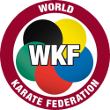There are two categories of prohibited behaviour, Category 1 and Category 2.
- Home
- Exam questions
-
Rules
- KUMITE RULES
- KATA RULES
- APPENDIX 1: THE TERMINOLOGY
- APPENDIX 2: GESTURES AND FLAG SIGNALS
- APPENDIX 3: OPERATIONAL GUIDELINES FOR REFEREES AND JUDGES
- APPENDIX 4: SCOREKEEPERS MARKS
- APPENDIX 5: LAYOUT OF THE KUMITE COMPETITION AREA
- APPENDIX 6: LAYOUT OF THE KATA COMPETITION AREA
- APPENDIX 7: THE KARATEGI
- APPENDIX 8: WORLD CHAMPIONSHIPS: CONDITIONS & CATEGORIES
- APPENDIX 9: REFEREES AND JUDGES TROUSERS COLOUR GUIDE
- APPENDIX 10: KARATE COMPETITION FOR THOSE UNDER 14 YEARS OF AGE
- APPENDIX 11: VIDEO REVIEW
- APPENDIX 12: OFFICIAL PROTEST FORM
- APPENDIX 13: WEIGH-IN PROCEDURES
- APPENDIX 14: ROUND-ROBIN COMPETITION (KUMITE)
- APPENDIX 15: ORGANISATION OF OLYMPIC KATA COMPETITION
- APPENDIX 16: PREMIER LEAGUE KATA COMPETITION
- KUMITE RULES 2018
- KATA RULES 2018
- APPENDIX 1: THE TERMINOLOGY 2018
- APPENDIX 2: GESTURES AND FLAG SIGNALS 2018
- APPENDIX 3: OPERATIONAL GUIDELINES FOR REFEREES AND JUDGES 2018
- KUMITE RULES 2015
- KATA RULES 2015
- Premium account
- About

